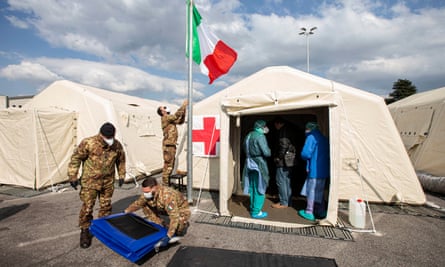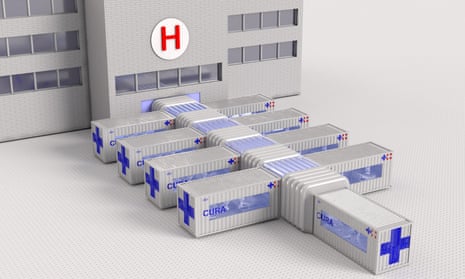Architects have turned to shipping containers to make everything from pop-up shops to co-working spaces, and even teetering towers of student housing. But now the humble corrugated steel box might have found one of its most useful reincarnations yet, in the hands of an international network of architects and engineers who have come together to convert them into two-bed intensive care units for the coronavirus pandemic.
“A group of us started talking a week ago, wondering how could contribute our skills to this emergency,” says Carlo Ratti, an Italian architect based in Boston, where he teaches at the Massachusetts Institute of Technology. “We all know there is a massive need for more intensive care units across the world, but there are problems with the two existing solutions – as an official report from the Chinese government found, based on their experience of the virus.”
One current solution, he says, is to take a convention centre and fill it with lots of beds, creating a field hospital overnight, as is now planned for the ExCel centre in east London. There is efficiency in the numbers, but Chinese authorities found that problems were caused by the intense concentration of contaminated air, with the result that many more of the medical staff became infected. The second solution is prefabricated hospitals, kitted out with the full mechanical ventilation and negative pressure systems needed for bio-containment, but which take several months to complete.
“We thought, is there any way that you can get the speed of convention centre or tent hospital, mounted in a few hours or a couple of days,” says Ratti, “but at the same time have something that is as safe as the prefab hospital?”

Their solution is Cura (Connected Units for Respiratory Ailments), a plan to pack all the features of an intensive care unit, complete with extractors to create negative air pressure, inside a 20-foot shipping container, able to be transported anywhere and deployed in just a few hours.
Working with fellow architect Italo Rota, Humanitas Research Hospital, Milan Polytechnic, Jacobs engineers, and a pool of leading European physicians and experts in emergency management, Ratti has got funding from UniCredit to develop the first prototype, which is being manufactured in Turin. It will be deployed at a hospital in Milan, one of the epicentres of the pandemic. The designs are being made available as open source plans online, and the team hopes that it will be copied around the world. They are talking to several automotive manufacturers who might be able to mass-produce the units.
“The key thing is the ease with which you can move these pods around,” says Ratti. “The waves of the virus travel to different regions so quickly, so we need to be able to deploy the intensive care units wherever they are needed most. The advantage of the shipping container is that the infrastructure for moving them already exists.”
The pods have been designed to work as standalone units, or they can be connected by an inflatable corridor structure to create larger, multi-bed clusters. Ratti imagines the units being set up alongside existing hospitals, taking over car parks and leftover space, or being deployed as self-contained field hospitals. He estimates that each two-bed pod can be produced for around $100,000, including all medical equipment, around a third of the pre-bed cost of an emergency prefabricated hospital.
